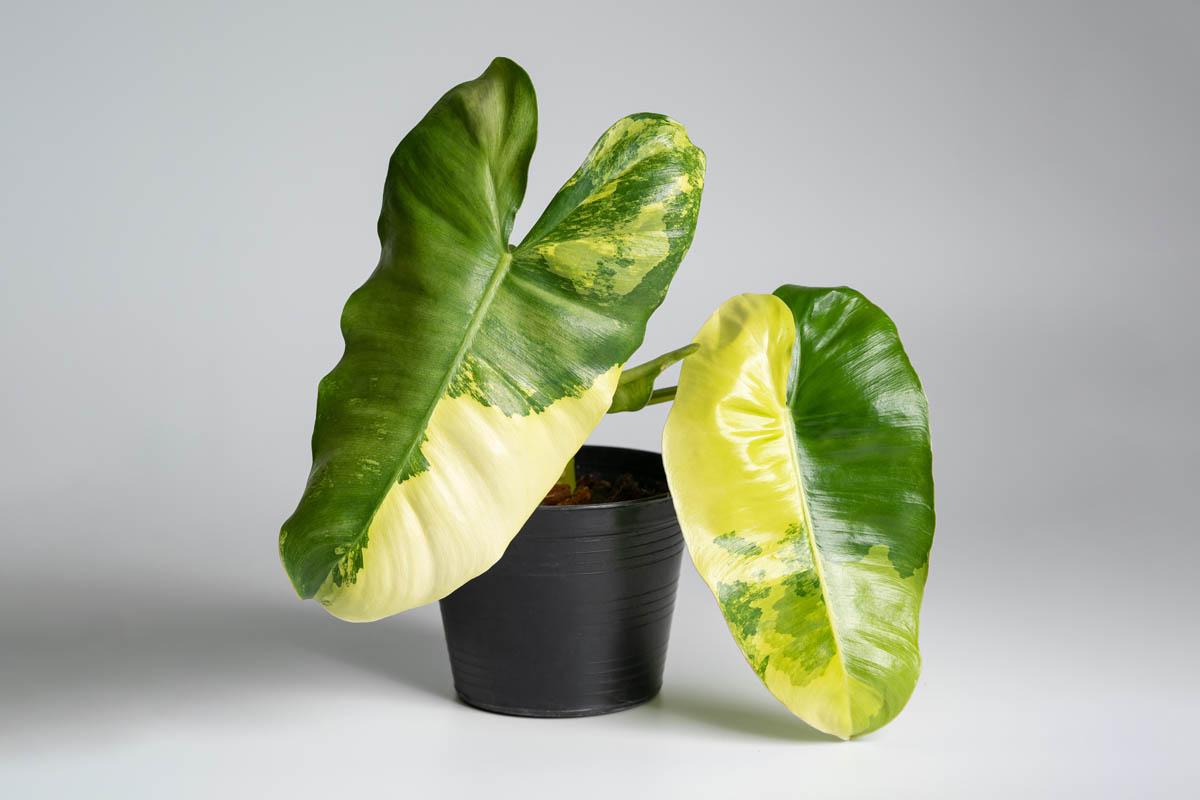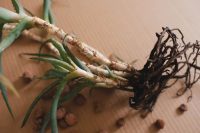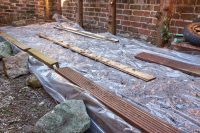Overview
Pythium (pronounced pie-thee-um), are parasitic oomycetes (water moulds) made up of 200 species worldwide¹, most of which are pathogenic to plants. Oomycetes along with fungi are the most common pathogens involved in root rot and damping off, both of which are highly fatal to their host.
Oomycetes are a large group of land and aquatic eukaryotic (nucleated) organisms with fungi-like similarities. Pythium was in fact classified as fungi for 150² years but has now moved to the kingdom Chromista.
Most species of Pythium are plant parasites, but a small number infect animals. The parasite feeds on the juvenile plant root tips and can make its way up to the stem. The infected plant loses its ability to absorb water and nutrients from the soil due to the damaged root system. Some species are pathogenic at temperatures above 25°C (77°F), and some are active in low temperatures³. When Pythium kills newly emerged seedlings, it is known as damping-off. Wet and humid conditions are favourable to Pythium species.
Terminology
- Antheridium – Male sex organ
- Appressorium – Specialised flattened hyphae that produce a minute plug that enters the host by punching through the cell wall
- Chlamydospores – Thick-walled large resting spores
- Dictyosomes – Net-like membrane-bound structures that contain Golgi apparatus, a cell organelle responsible for transporting, modifying, and packaging proteins and lipid molecules into vesicles for transport to their eventual destination
- Hyphae – Filamentous structure
- Mycelium – Root-like structure of fungus and water moulds
- Oogonium – The female sex organ
- Oospore –
- Protoplasts – Cells with the entire wall removed
- Saprophytically – An organism that obtains nourishment from dead organic materials
- Sporangia – A structure that makes and stores spores
- Sporangium – An enclosure in which spores are formed
- Zoospores – Motile asexual spore
- Zoosporangium – Sporangium-bearing zoospore
Pythium life cycle
Pythium reproduces asexually or sexually. Thick-walled oospores or mycelial fragments can survive hostile conditions in the environment for up to ten years⁴. When conditions are right (water and chemical signals from nearby germinating seedlings or plant roots), the production of sporangia is triggered.
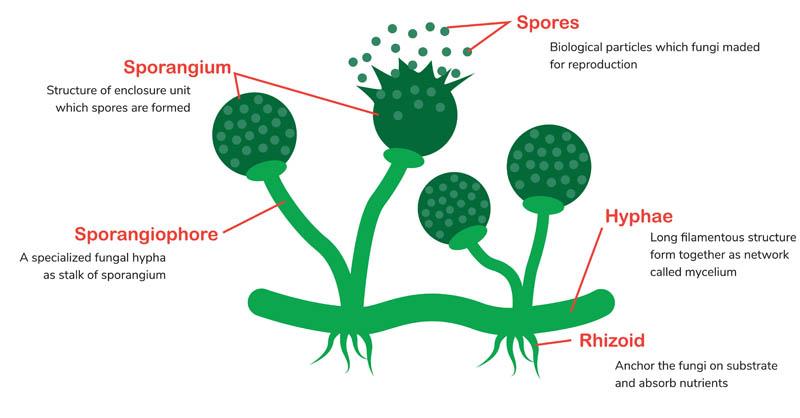
- The sporangium is formed on the end of branched hyphae (filamentous structures) outside the root of the infected host. Multinucleated sporangia can be classified into two types; globose and filamentous or elongated.
- Sporangia detach from the hyphae and are disbursed. When a host is found, the sporangia form a cyst, germinate, produce a germ tube and make contact with the root surface by forming an appressorium. Pectinolytic enzymes denigrate the plant cell wall and enable penetrating hyphae to enter the root and colonise the cortex, destroying the cell walls.
- In cold, wet conditions, the mature zoosporangium (sporangium-bearing zoospores) is an elongated multinucleate structure, the contents of which divide into numerous uninucleate daughter protoplasts. The apex of the zoosporangium swells into a small, thin-walled vesicle, and the protoplasms migrate into it and metamorphosis into crescent-shaped flagellated zoospores.
- Movement of the zoospores causes the vesicle wall to rupture, releasing the mature zoospores. Zoospores are attracted by organic compounds released by plant roots known as exudates. Once the zoospores find a host, they attach to the root surface, form a thick wall, change their shape to spherical and become cytospores (cysts). Under favourable conditions, cytospores can directly germinate and form a new mycelium (root-like structure) or produce secondary zoospores that germinate.
- Sexual reproduction occurs after the death of the host at the end of the growing season. Pythium lives saprophytically (obtains nourishment from dead organic materials). Oogonium (the female sex organ) arises from the mycelium in the infected plant. A round swelling forms and separates from the mycelium (the entire filamentous hyphae). The hyphae form a round swelling that fills with cytoplasmic contents (nuclei, mitochondria, vacuoles, vesicles and dictyosomes) from the hyphae and separates. This swollen globe is the female reproductive organ. The antheridium (male sex organ) fertilises the oogonium which produces an oospore (thick-walled zygote).
Dispersal of Pythium
Pythium spreads via infested soil, decaying plant fragments and contaminated water and the method of dispersal depends on the spores.
- Zoospores are dispersed via contaminated water, including runoff, water splashes and contaminated bodies of water.
- Chlamydospores and oospores are released from decaying plant matter, usually late in the cycle. Benches, gardening equipment, soil, potting mix, dust, hose heads, plant pots, clothing and footwear can all disperse chlamydospores and oospores.
What are the signs of root rot in plants?
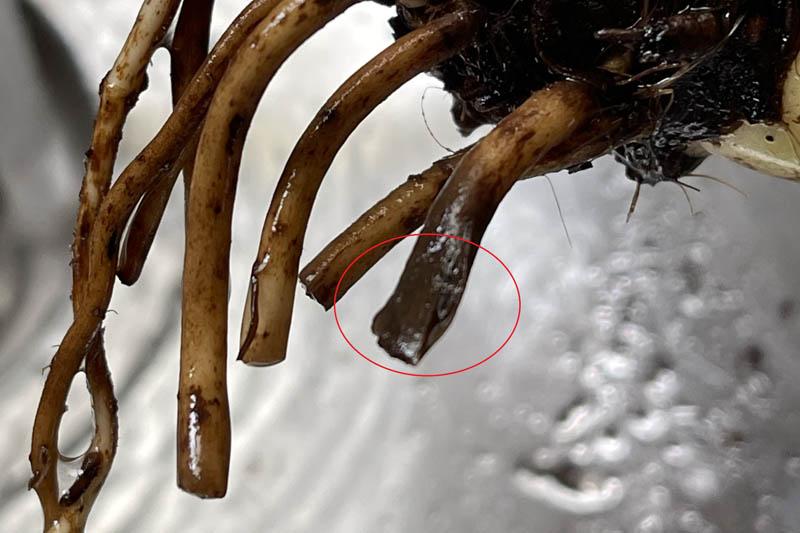
Root rot is an insidious disease as the damage occurs beneath the soil, which makes it difficult to detect until it is too late.
- Wilting leaves
- Sunken chlorotic (yellow) leaves
- Crown rot
- Discolouration of leaves, followed by brown spots
- Leaf drop
- Rat tail roots (the outer cortex sloughs off the roots, leaving a strand of vascular tissue)
- Stunted growth
- Dieback
- Plant death
Treatment
If the plant is easily replaceable, it is safer to carefully dispose of the plant by placing it in a plastic bag in the garbage. Do not add infected plants to the compost bin. Gardeners and plant growers may choose to attempt to save a valuable plant, but may only be possible if rot is caught early enough, and the plant still has some healthy roots. If all the roots are mushy, unfortunately, it is too late to save the plant.
Fungicides can protect and treat plants with root rot. Fungicides used to control Pythium include etridiazole (Terrazole CA), propamocarb (Banol and Previcur), fluopicolide (Adorn), cyazofamid (Segway), fenamidone (Fenstop) and mefenoxam (Subdue Maxx). Pythium can develop resistance to certain fungicides⁵.
Good sanitation is critical when handling plants with root rot. Sterilise equipment before treating a plant, and wear disposable gloves.
- Place the palm of your hand over the top of the pot with one side of the stem between the thumb and index finger, and the other side between the remaining fingers. Tilt the pot upside down and carefully slide it out of the pot. Discard the pot and potting medium.
- Tease apart the roots and inspect for signs of root rot. Remove as much soil as you can from the roots under the tap.
- Wash and sterilise hands, and put on a pair of disposable gloves. Remove any black and mushy roots with a pair of sterile gloves.
- Apply fungicide as per instructions. Alternatively, add 20% hydrogen peroxide (3% strength) and 80% lukewarm water and place the rootball into the water/H₂O₂ mix for 2 hours. Remove and place in a sterile pot with fresh potting medium.
Biological control
Several biological agents have been found to prevent or suppress Pythium species.
| Streptomyces griseoviridis (Mycostop) | A preventative product that colonises the area around plant roots (rhizosphere) to create a biological defence against a number of soil-borne pathogens including Pythium species. |
| Trichoderma virens | A soil-dwelling saprophyte (fungi) has been found to inhibit the mycelial growth of Pythium spp. by producing the antibiotic gliovirin⁷. |
| Pseudomonas fluorescens | A gram-negative bacteria root inoculum that quickly colonises the rhizosphere receives nutrients and protection while inhibiting soil pathogens by producing antibiotic-like substances and hydrogen cyanide. |
Sterilising garden equipment
Garden tools, greenhouses, potting benches and reusable pots should be sterilised with bleach to avoid cross-contamination.
Scrub tools and equipment soap and water to remove all organic matter before sterilising. When bleach comes into contact with organic matter, the organic matter reacts with the hypochlorite ions, producing chloramines, which are less effective at oxidising and disinfecting. Chloramines are also less soluble in water and can form solids, causing discolouration and staining. Organic matter on surfaces can also provide a protective barrier that shields microorganisms from the full strength of bleach which reduces the ability of bleach to disinfect.
Once organic matter has been removed, apply a solution of 10% bleach, and 90% water and soak for 30 minutes. Rinse thoroughly, allow to dry in the sun and store off the ground.
Prevention
Solarisation
- Solarise infected garden beds after a Pythium outbreak. Solarisation is a broad-spectrum, chemical-free technique used to kill weeds, weed seeds and pathogens (fungi, oomycetes, bacteria, plant parasite nematodes, mites) utilising solar energy and clear plastic sheeting to trap heat in the upper soil layers. Studies have found several fungal pathogens have been almost completely eradicated using solarisation⁶ including Fusarium spp., Phytophthora spp., Pythium spp., and Sclerotium spp.
Water carefully
- Overwatering is a major cause of root rot in houseplants and plant owners must know the watering needs of each plant instead of a one-size-fits-all approach. Most people check potting medium by inserting a finger into the top 2.5 cm (1 inch) of soil.
- Most houseplants are grown in decorative pots with a tray to prevent water from damaging furniture. If possible, water in the sink or shower, and allow the water to drain from the pot before returning it to its decorative pot.
Increase soil drainage
- Adding coarse sand to poorly draining soil can improve drainage, or grow plants in raised beds.
- Well-draining plastic orchid pots can be used inside decorative pots to improve drainage. The plastic pot can be removed, and the plant watered in the sink to allow water to run out and placed back in the decorative pot. As insurance, always choose a decorative pot with at least one drainage hole.
Use the right potting medium
- Choose an appropriate substrate based on specific species requirements. Succulents require well-draining soil and like to stay on the dry side. Aroid mixes usually include potting mix, orchid bark, leca or perlite to improve aeration and drainage. These are easy to make at home.
Eliminate fungus gnats
- Fungus gnats are small insects that feed on organic debris in the soil, while doing so, they can act as a vector when they damage plant roots as they feed. Overwatering can attract fungus gnats, which highlights the importance of avoiding doing so. I had a recent outbreak of fungus gnats and found the sticky traps caught some, but not all of the adult gnats. As these traps only kill adult fungus gnats, larvae on the soil continue to mature and the problem returns. The problem was solved by adding a layer of leca to the top of the soil to block the gnats from their food source.
Store hose ends off the ground
- Keep hose ends off the floor to prevent contamination with infested soil or dust.
Preventing root rot in the garden can be a challenge as we are at the mercy of Mother Nature. Anybody who lives on the east coast of Australia has experienced three years of almost constant rain which has had a devastating impact on farmers, nurseries and home gardens. My vegetable is completely saturated and practically unusable. The only plants still alive are a fig, nasturtium and some fennel. I created a small potted herb garden, with all plants in terracotta pots sitting on clay feet to allow water to drain out of the pot.
REFERENCES
- Pythium
- Lévesque, C. A. (2007). Phylogeny and taxonomy of the fungal genera Phytophthora and Pythium. In Phytophthora (pp. 25-41). Springer, Dordrecht.
- Pythium Root Rot
- Pythium Damping off of Soybean
- Survey of Pythium Isolates for Resistance to Metalaxyl
- Soil Solarisation and Sustainable Agriculture
- Understanding the Mechanisms Employed by Trichoderma virens to Effect Biological Control of Cotton Diseases
Julia is a writer and landscape consultant from Wollongong with a love of horticulture. She had been an avid gardener for over 30 years, collects rare variegated plants and is a home orchardist. Julia is passionate about learning and sharing her knowledge of plant propagation and plant toxicology. Whether it’s giving advice on landscape projects or sharing tips on growing, Julia enjoys helping people make their gardens flourish.
